
San Francisco’s history begins with the Ohlone people, who inhabited the area for thousands of years before European contact. They lived in small villages and were skilled hunters and gatherers, thriving on the region’s abundant natural resources.
Spanish Colonization
The first Europeans to arrive were Spanish explorers led by Gaspar de Portolá in 1769. In 1776, the Spanish established the Presidio of San Francisco and Mission San Francisco de Asís (Mission Dolores), marking the beginning of Spanish colonization. The mission aimed to convert the indigenous population to Christianity and integrate them into Spanish colonial society.
The Gold Rush
The discovery of gold in the Sierra Nevada in 1848 transformed San Francisco from a small settlement into a booming metropolis. The Gold Rush brought a massive influx of fortune seekers, increasing the population from a few hundred to over 25,000 in just a few years. The city’s port became a hub for trade and immigration, contributing to its rapid growth and diverse population.
The 1906 Earthquake and Rebuilding
On April 18, 1906, a devastating earthquake struck San Francisco, followed by a massive fire that destroyed much of the city. Approximately 3,000 people died, and over 80% of the city was destroyed. The reconstruction of San Francisco was swift, with new building codes and architectural advancements contributing to its rebirth as a modern city.
Mid-20th Century and Counterculture
In the 1950s and 1960s, San Francisco became a center for the Beat Generation and later the counterculture movement. The Haight-Ashbury district was the epicenter of the 1967 Summer of Love, attracting thousands of young people drawn to the city’s progressive politics and artistic freedom. The counterculture movement influenced music, art, and social norms of the city.
The Bay Area and “Manhattanization”
The Bay Area’s economy expanded rapidly in the latter half of the 20th century, driven by the growth of the technology sector in nearby Silicon Valley. San Francisco experienced a period of “Manhattanization,” characterized by the construction of high-rise buildings and increased urban density. This development transformed the city’s skyline and contributed to its status as a global financial and cultural center.
The Dot-com Era
In the late 1990s and early 2000s, the dot-com boom brought another wave of economic growth and technological innovation to San Francisco. Numerous internet startups and tech companies were founded, attracting talent and investment to the city. However, the dot-com bust in 2000 led to economic downturns and job losses, but the city eventually rebounded as the tech industry recovered.
Recent History and Social Issues
In recent years, San Francisco has faced significant challenges, including a growing homeless population, rising housing costs, and social inequality. These issues have been exacerbated by the COVID-19 pandemic, which led to economic disruptions and an increase in remote work. Several major companies and retail stores have left the city due to high operating costs and concerns about safety and homelessness.
Efforts to address these issues include initiatives to increase affordable housing, improve social services, and enhance public safety. The city’s future remains uncertain as it navigates these complex challenges, balancing economic growth with social sustainability.
-Lê Nguyễn Thanh Phương-
